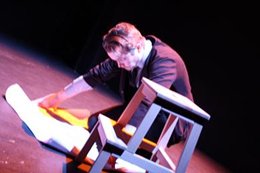Perhaps given the national tragedy brought on in recent years by feckless building and development, Irish theatre audiences might have a particular soft spot for the existential musings of a world-weary architect. I like to think Vincent A. O’Reilly had this in mind when he decided to reimagine Henrik Ibsen’s The Master Builder. Halvard Solness, the architect in question here, stares pitilessly into a spiritual chasm over this three act play, pondering how a career full of promise has left him paranoid, joyless and the verge of total breakdown.
The Master Builder was written in 1892, yet perhaps the greatest strength of Sheer Tantrum’s new production at the New Theatre is the way it makes the play feel contemporary. O’Reilly’s stripped-down version does so by removing much of the specificity to the Norwegian society Ibsen was writing for. This production eschews the middle-class furnishings that decorate Solness’ life - the “plainly-furnished work-room” and other various domestic fittings – for an entirely bare set, bar an Ikea footstool. The actors wear plain costumes. The emphasis is squarely upon the power of Ibsen’s words.
 Ibsen’s text is light on story and heavy on symbolism, with the language of architecture charting both Solness’ rise and fall. Played with a brooding solipsism by Patrick O’Donnell, Solness made his name building churches, but he has depressingly spent much of his recent career building ordinary homes for ordinary citizens. He and his wife Aline (Melissa Nolan) are still reeling from the fire to their home (Aline’s family estate) that led to the death of their two sons. Solness seems to spend much of his time courting his secretary Kaja Fosli (Áine Lane), fiancée of fellow architect Ragnar Brovik (Aidan Keane), and fearing the rise of a new generation. When that next generation arrives towards the end of Act One – literally knocking at his front door, as Solness confers with his doctor Herdal (Duncan Lacroix) – in the guise of Hilde Wangel (Jane Myers), a doe-eyed young woman from a past Solness can barely remember, the master builder catches a glimpse of his fearless younger self and believes (foolishly, it turns out) that he can transcend his own despair.
Ibsen’s text is light on story and heavy on symbolism, with the language of architecture charting both Solness’ rise and fall. Played with a brooding solipsism by Patrick O’Donnell, Solness made his name building churches, but he has depressingly spent much of his recent career building ordinary homes for ordinary citizens. He and his wife Aline (Melissa Nolan) are still reeling from the fire to their home (Aline’s family estate) that led to the death of their two sons. Solness seems to spend much of his time courting his secretary Kaja Fosli (Áine Lane), fiancée of fellow architect Ragnar Brovik (Aidan Keane), and fearing the rise of a new generation. When that next generation arrives towards the end of Act One – literally knocking at his front door, as Solness confers with his doctor Herdal (Duncan Lacroix) – in the guise of Hilde Wangel (Jane Myers), a doe-eyed young woman from a past Solness can barely remember, the master builder catches a glimpse of his fearless younger self and believes (foolishly, it turns out) that he can transcend his own despair.
O’Reilly’s efforts to peel back the spiritual void that animates The Master Builder have an interesting effect. The cast is smaller, for one. He reduces Knut Brovik, the patriarchal figures who started the architectural firm that now Solness runs, to a mere offstage presence, whereas Ibsen gave him the first speaking part in the play. (Brovik’s son Ragnar inherits many of these lines.) The audience arrive to the theatre to find the cast quietly repeating a number of imaginary tasks on stage. Members of the cast also engage in ponderous between-act duties like dropping flower petals from the stage. They have no profound link to the text, but coupled with Colm Ivers’ subtle lighting design, these gestures bring Ibsen’s characters into a more contemporary context.
.JPG.aspx%3Fwidth=260&height=173) Yet for all this effort to provide a new perspective on the inner lives of the characters, the cast is unfortunately not always equal to the dramatic power of the text. Myers, for instance, plays Hilde with a dexterous desirousness, but her accent often slipped between the mid-Atlantic and something you might hear in south Dublin. Nolan’s Aline is almost too grief-stricken: her thousand-yard stare gave her coldness that felt almost robotic by the end. (That said, one of the most powerful scenes in this production is the moment Aline and Hilde share on stage together at the beginning of the third act.)
Yet for all this effort to provide a new perspective on the inner lives of the characters, the cast is unfortunately not always equal to the dramatic power of the text. Myers, for instance, plays Hilde with a dexterous desirousness, but her accent often slipped between the mid-Atlantic and something you might hear in south Dublin. Nolan’s Aline is almost too grief-stricken: her thousand-yard stare gave her coldness that felt almost robotic by the end. (That said, one of the most powerful scenes in this production is the moment Aline and Hilde share on stage together at the beginning of the third act.)
There’s an inevitability about Solness’ ultimate fall but that doesn’t make it any less powerful. The architect attempts to revisit the feat that enthralled him to the teenage Hilde – placing a wreath upon the tower he has built for himself and Aline – with disastrous consequences. The dramatization of the fall is typically threadbare, as Solness simply ascends the steps of the theatre. But as the audience files out of the theatre, they pass the wreath sitting forlornly. This is not a perfect adaptation of The Master Builder but there is always grim pleasure in watching Ibsen’s protagonists wrestle with their fate.
Donald Mahoney